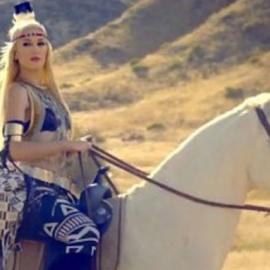Recent controversy over a music video released by the band No Doubt has raised questions not only about the appropriation of Native American heritage, but also about the often-unintended nature of appropriation. The video of No Doubt’s song ‘Looking Hot’ features band members dressed as … well, cowboys and Indians.
Due to complaints of the racist and sexist imagery contained, the video was quickly pulled from circulation (but is still available on some obscure websites). In response to the outcry over the video, No Doubt put out this apology on their website:
“As a multi-racial band our foundation is built upon both diversity and consideration for other cultures. Our intention with our new video was never to offend, hurt or trivialize Native American people, their culture or their history. Although we consulted with Native American friends and Native American studies experts at the University of California, we realize now that we have offended people. This is of great concern to us and we are removing the video immediately. The music that inspired us when we started the band, and the community of friends, family, and fans that surrounds us was built upon respect, unity and inclusiveness. We sincerely apologize to the Native American community and anyone else offended by this video. Being hurtful to anyone is simply not who we are" (link).
Numerous commentaries about the video have focused on what many regard as inappropriate use of Native culture. Some of these are collected in Adrienne Keene’s wonderful website, Native Appropriations, as well as in the international press coverage (e.g., see The Guardian). There is a very rich seam to mine here regarding what constitutes appropriation of clothing, hairstyles, symbols, and other cultural expressions, an issue that has great relevance to many of the communities IPinCH is working with.
But the point to highlight here concerns No Doubt’s stated efforts to consult with Native Americans and others during the making of the video. I have no doubt (no pun intended) they did that, questionable taste aside. But the obvious question for discussion is “who should be consulted?” Granted, the cowboy- and Indian-themed video is clearly a mélange of heritage and Hollywood; and perhaps those Native American friends and Native American studies experts concurred in that about the nature of the video’s imagery. But how does that group speak for other Native Americans? Here is a situation emerging in popular culture similar to that encountered in ethnographic and community-based research; who speaks for the community, and how does one navigate the complex issue of individual vs. group opinion? While it may always be difficult to reach consensus regarding permission to use or reproduce heritage images (there remains much divided opinions among Inuit over the use of inukshuk in the 2010 Olympics, for example), as well as stories, clothing styles, and music, at least some make efforts to ask permission. And this holds true within Indigenous communities themselves where youth may seek to blend traditional music with hip-hop, or tribal members seek to use petroglyph images for a store logo (Atalay et al. 2009).
Given that so much of contemporary culture is based on borrowings, examples like the No Doubt video or the controversy over Victoria Secret models parading in lingerie and feathered headdresses (CBC 2012) will continue to provide many opportunities to discuss the fine line between inspiration and copying, artistic license and mischief, or respectful borrowing and harmful appropriation.
Photograph: screenshot from No Doubt's video "Looking Hot."
References and Resources
Atalay, Sonya, Shannon Martin, and William Johnson. 2009. Education, Protection and Management of ezhibiigaadek asin (Sanilac Petroglyph Site). Case Study Proposal to IPinCH Steering Committee.
Brown, Michael. 2004. Who Owns Native Culture. Harvard University Press, Cambridge.
CBC. 2012. “Victoria's Secret apologizes for use of headdress.”
Riley, Mary (editor). 2004. Indigenous Intellectual Property Rights: Legal Obstacles and Innovative Solutions. AltaMira Press, Walnut Creek, CA.
Scarre, Geoffrey, and Robin Coningham (editors). 2012. Appropriating the Past: Philosophical Perspectives on the Practice of Archaeology. Cambridge University Press, Cambridge and New York.
Young, James, and Conrad Brunk (editors). 2009. The Ethics of Cultural Appropriation. Wiley-Blackwell, New York.
The Appropriation (?) of the Month feature, written by IPinCH team members, highlights examples of uses of intellectual property that might be considered appropriations.






